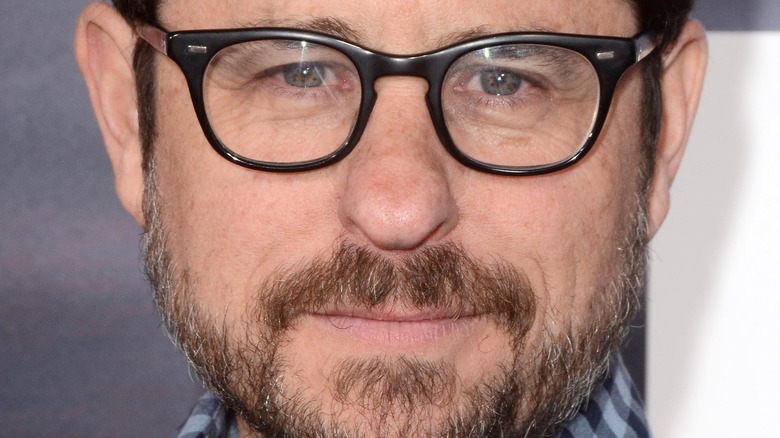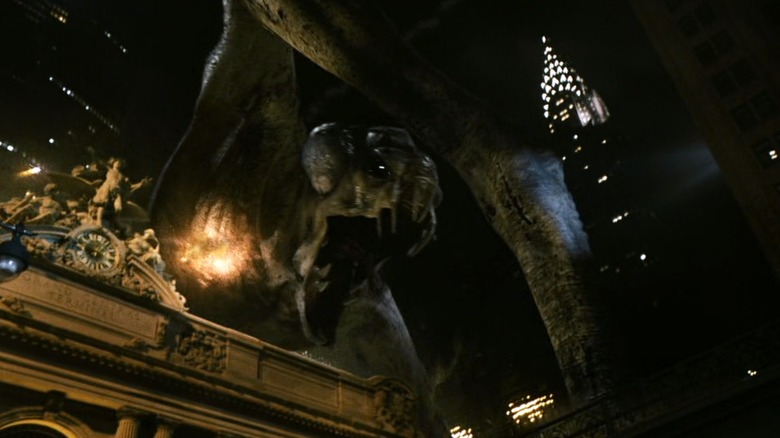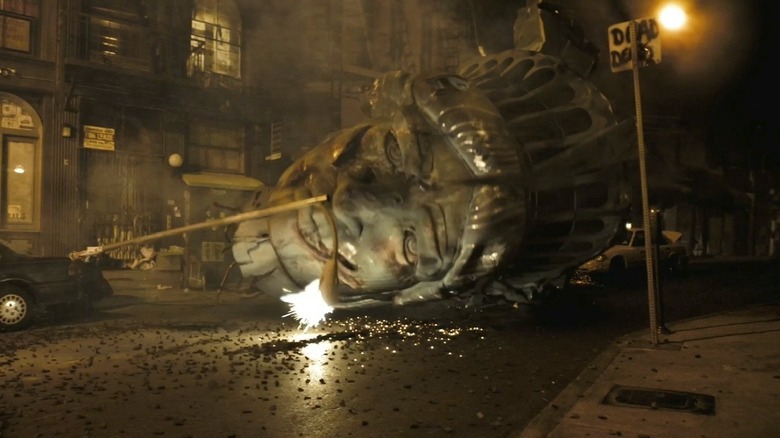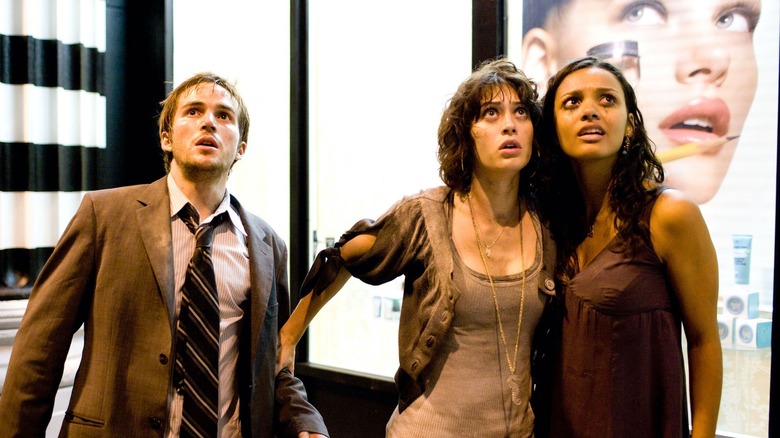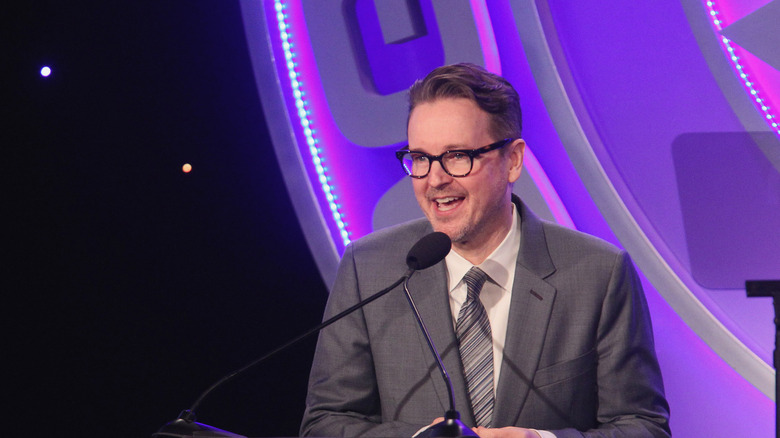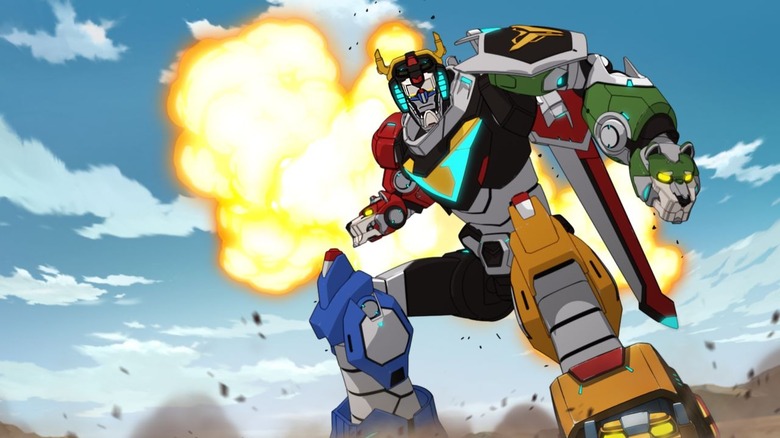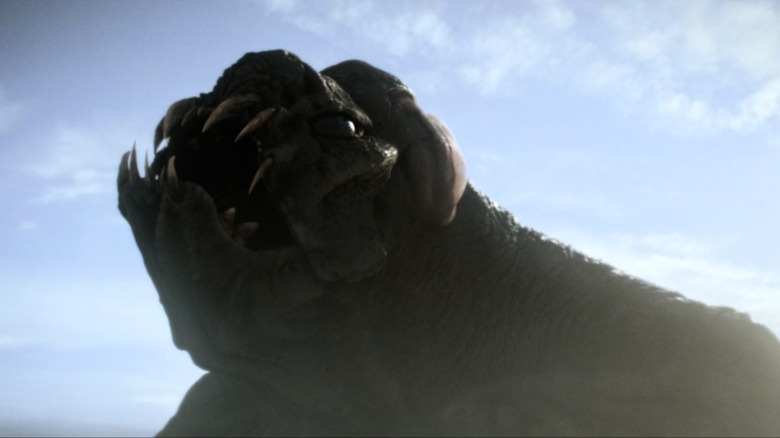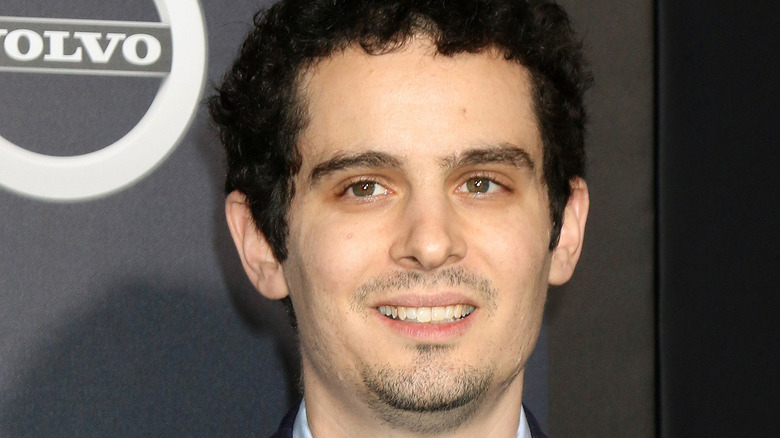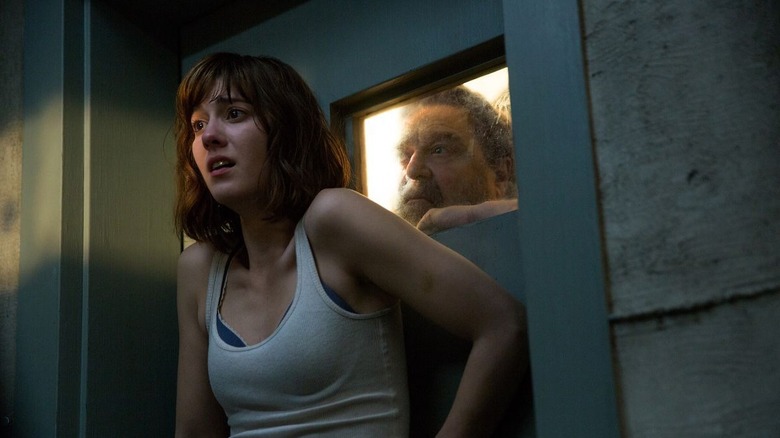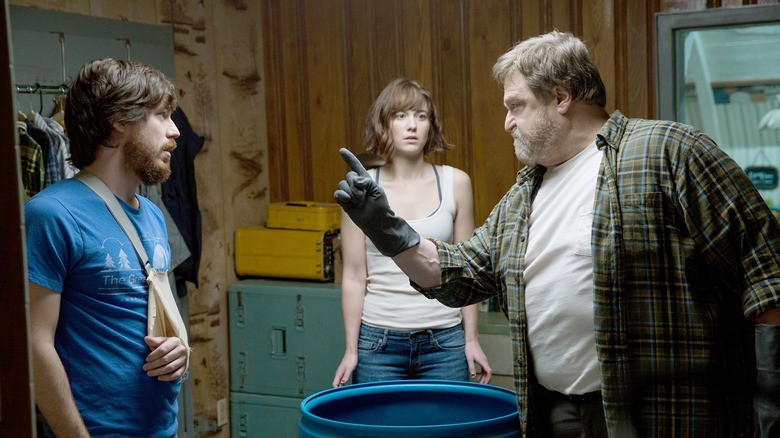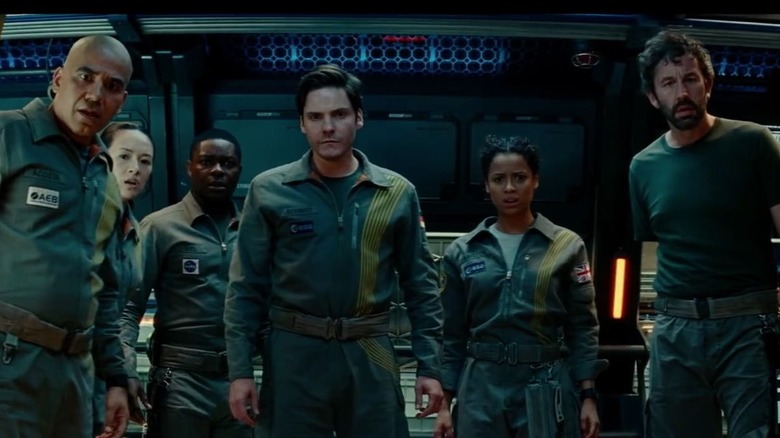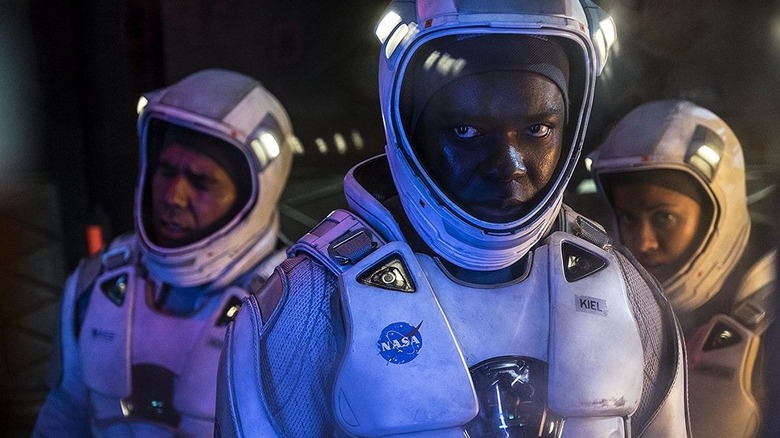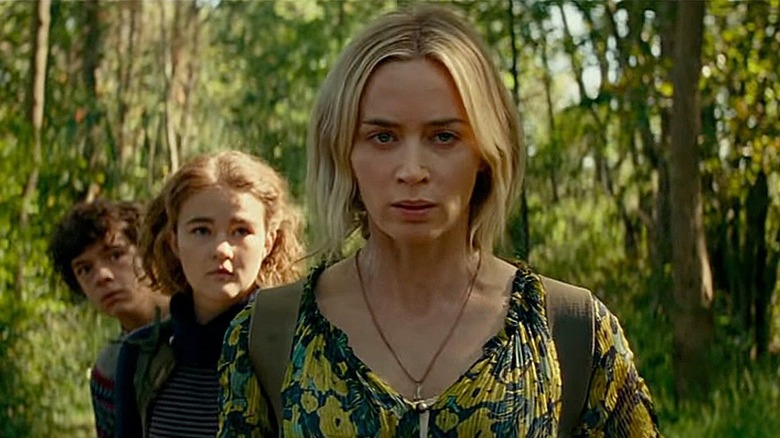The Untold Truth Of The Cloverfield Franchise
When "Cloverfield" first emerged in the consciousness of general pop culture in summer 2007, nobody even knew what it was. That's what happens when your first teaser trailer arrives with no pre-release hype and when that trailer concludes not with a title but with a date. But soon, "Cloverfield" turned into a robust box office hit and even scored, at the time, the biggest opening weekend ever for a movie bowing in January. Even after its theatrical release wound down, "Cloverfield" still attracted interest from people and garnered enough of a following to ensure that its title would live on through a spiritual successor, "10 Cloverfield Lane." The 2018 feature "The Cloverfield Paradox" deepened the franchise's lore by delivering more explicit connections to the world of the original "Cloverfield."
Die-hard "Cloverfield" fans and general moviegoers are all knowledgeable about the existence of this trio of features but what even the most dedicated "Cloverfield" devotee may not be aware of are various aspects of the untold truth of the "Cloverfield" franchise. Given how much this collection of movies has been drenched in secrecy, it should be no surprise that there are also tons of lesser-known factoids about this series. The "Cloverfield" franchise has a dense history, both within its in-movie universe and the assorted stories of how this series came to be.
Where the inspiration for Cloverfield came from
J.J. Abrams has built his career on echoing genre movies of the past, so it isn't a shocker to discover that he conjured up "Cloverfield" as a way of paying tribute to classic kaiju movies. However, the circumstances that informed this were rooted in a more specific personal experience, one that made Abrams realize the status of American-made monster movies.
"I was in Japan over a year ago with my son who is 8 and all he wanted to do was go to toy stores. We went to a store and saw Godzillas everywhere and I thought what better. We need our own monster," Abrams told Movies Online. "We need a monster movie. I love King Kong! King Kong is just adorable and Godzilla is a charming monster. I love Godzilla but I wanted something that was just insane and intense." From this toy store encounter sprang a desire that fueled the creation of not just the original "Cloverfield" but an entire sprawling franchise. In the process, Abrams did indeed create an ultra-intense monster that could stand up to the most harrowing cinematic beasts, the kind of entity that could indeed populate the shelves of your average toy store.
Escape from New York inspired the Statue of Liberty's fate
One of the most evocative parts of the marketing for "Cloverfield" was the emphasis on the beheading of the Statue of Liberty. The decapitated head closed out the film's initial teaser trailer with a bang, while a headless Lady Liberty was the centerpiece of "Cloverfield's" poster. In lingering on this particular piece of destruction, "Cloverfield" instantly created an aura of fear and dread with its marketing materials. The Statue of Liberty is something we all assume will always stand in New York City, its consistent presence comforting. When that gets threatened by an unknown menace, well, that's bound to send a chill up your spine.
This effectively unnerving piece of mayhem was actually inspired by the marketing materials for a classic 1980s action movie. "The inspiration came from the poster of 'Escape from New York,'" director Matt Reeves said to IGN about the Statue of Liberty's head. "The poster had an image on it of the head of the Statue of Liberty and that image was nowhere in the movie! And it's an incredibly provocative image. And that was the source that inspired [producer] J.J. [Abrams] to say, 'Now this would be an interesting idea for a movie.'" Add in another reason to love John Carpenter's "Escape from New York."
All the alternate titles for Cloverfield
The title for the original "Cloverfield" did not just spring up out of thin air. In fact, the project went under several working titles before settling on its final moniker. In September 2007, SlashFilm reported how the title "Cloverfield" was once ditched in favor of subsequent names like "Slusho," "Chocolate Outrage," and "Cheese." This constant retitling was even referenced in an image of a production crew gift that featured the various alternate titles humorously crossed out.
The SlashFilm piece noted how "Cloverfield" had no title at the time, with its teaser trailer only delivering a 1-18-08 release date, before reporting that the Matt Reeves-directed film might end up going by the name "Wreck." All this was done to keep a veil of secrecy over "Cloverfield" — the project was defined by keeping things cryptic and the title had to constantly change to keep up that reputation. As for why certain titles were ditched — beyond online fans recognizing they were associated with "Cloverfield" — monikers such as "Cheese" were likely never considered serious contenders given how they significantly clashed with the grim tone of the actual film.
Of course, the production's second trailer in November 2007 would eventually cement "Cloverfield" as the project's proper title and subsequent follow-ups would further turn "Cloverfield" into a recognized genre brand. Despite its ubiquity today, though, the "Cloverfield" team was constantly second-guessing just what this unique monster movie should be called.
How Matt Reeves viewed Cloverfield as relevant
Monster movies tend to function as much as sociopolitical commentary as they do opportunities to watch big beasts topple buildings. Just look at the 1954 "Godzilla," a reflection on Japan's nuclear anxiety. In the case of "Cloverfield," director Matt Reeves had a very specific idea of what this particular monster movie, captured through the lens of found footage, was meant to say about the time in which it was released.
"'Cloverfield' very much speaks to the fear and anxieties of our time, how we live our lives," Reeves told Shock Till You Drop. "Constantly documenting things and putting them up on YouTube, sending people videos through e-mail — we felt it was very applicable to the way people feel now." He further observed how a moment where the lead "Cloverfield" characters encounter another person filming everything happening around them was meant to "remind people that this is an Everyman experience. Media is so much an aspect of our lives today that even evoking that idea was exciting to us. That there could be different stories out there." By exploring these themes, "Cloverfield" was able to live up to the weighty subtext of past monster movies.
When Cloverfield was mistaken for a Voltron movie
Since the original "Cloverfield" teaser offered no title for the project, the Internet went into speculation overdrive trying to figure out what this movie was. The fan theories were relentless, as everybody tried their hand at figuring out the film's plot and the design of its monster. This led down some inaccurate but entertaining avenues, such as a YouTube video that attempted to deliver irrefutable evidence that Cloverfield was hiding its monster in the clouds on its poster.
One particularly fascinating notion was that "Cloverfield" was a stealth live-action film adaptation of the 1980s cartoon "Voltron." As noted by ScreenRant, the "Cloverfield" teaser trailer featured a moment where a man, while running away from the monster's attack, screams, "It's alive! It's huge!" However, many viewers were convinced they heard him say "It's a lion! It's huge!" This lead to speculation that this dialogue was referring to a piece of the "Voltron" robot. Coinciding with a point in time when a live-action "Voltron" movie was in development, this rumor caught fire, and the perception that "Cloverfield" was a "Voltron" movie in disguise began to gain traction as a legitimate concept. However, producer J.J. Abrams would soon debunk that particular rumor, with "Cloverfield" not attached to any pre-existing intellectual property. Now the whole "Cloverfield/Voltron" phenomenon is an amusing reminder of the downsides to ultra-cryptic marketing.
The emotions and animals that inspired the Cloverfield monster
While the beast was absent from the vast majority of the marketing for "Cloverfield," the film itself does eventually feature the creature that has come to be dubbed Clover. In the film, Clover only makes fleeting on-screen appearances, with the randomness and brevity of its on-screen presence meant to heighten the sense of uncertainty gripping the human leads. Despite its minimal screen time, though, lots of care went into this creature, particularly in what real-world inspirations would be used to define its underpinning emotions.
According to ScreenRant, a primary element emphasized in the monster's behavior was fear. Rather than maliciously choosing to rampage across New York City, Clover was designed to evoke elephants or horses that get terrified and begin to run amok. This lent an extra sense of terrifying uncertainty to the beast. There was no consistent evil plan motivating its actions — Clover was just engaging in random fits of destruction as a result of being frightened. On a visual level, underwater creatures like piranhas were channeled in the design of its face, a nod to how Clover is an outer space creature that landed in Earth's oceans.
Damien Chazelle was once involved with 10 Cloverfield Lane
Before he won an Oscar for Best Director for his work on "La La Land" and even prior to directing "Whiplash," Damien Chazelle was just another artist looking for his big break. At one point, that break looked like it might come from Bad Robot Productions. J.J. Abrams and company enlisted Chazelle to write and direct the original version of "10 Cloverfield Lane," then titled "Valencia."
"Actually, [Damien Chazelle] was originally coming on as a director as well, and he was working on the script to direct," Abrams recounted to Empire. "And 'Whiplash,' a short film he made, suddenly got funding to be turned into the incredible film it did and he went off to do that, which was his passion project ... but he did incredible work with [aspects of] plot and character with his draft." The eventual director of "10 Cloverfield Lane," Dan Trachtenberg, had nothing but positive things to say about the feature's original filmmaker. "I have so many things to thank him for," Trachtenberg said on The Q&A Podcast (via IndieWire). "He made ['Whiplash'] ... and because he ... made that awesome movie, I got a chance to make a movie, and he did a great job with the script. He really gifted me with so many things."
Damien Chazelle may have missed out on his chance to join the "Cloverfield" universe, but given where his career's gone since, it's doubtful that he's too miffed about that.
10 Cloverfield Lane was not originally part of the Cloverfield franchise
When "10 Cloverfield Lane" was filming, its cast and crew knew it as "Valencia," a low-budget thriller hailing from Bad Robot Productions. However, as production went on, something shifted. "Valencia" became a new spiritual sequel to "Cloverfield," with its title getting altered into "10 Cloverfield Lane." Rather than being the result of a longstanding plan kept secret by everyone involved in the film, attaching this project to the name "Cloverfield" was a last-minute switch.
"We wrote an original screenplay," director Dan Trachtenberg told MovieWeb about how this association came about. "'Cloverfield' was not in our mind at the time. During the development process, the idea came up that it could be in the Clover-verse. We were a bit surprised initially, but now when you see the movie; it makes a lot of sense in terms of tone, twists, turns, and the thriller aspect. It was definitely the right decision."
By attaching the "Cloverfield" name to "10 Cloverfield Lane," this new thriller was able to stand out more easily in a crowded marketplace. Meanwhile, crafting it as a standalone project allowed the film to function as a mostly separate narrative rather than just lean on "Cloverfield" shout-outs.
Why the original Cloverfield 2 was abandoned
For years after the original "Cloverfield" was released, there would be sporadic pieces of news that a direct follow-up was in development. Just a few weeks after the original movie debuted, director Matt Reeves even told Rotten Tomatoes that there were active concepts for where a follow-up could go. However, the busy schedules of all involved parties of the first "Cloverfield," particularly J.J. Abrams, was constantly brought up as a reason why the project wasn't moving forward. With the release of "10 Cloverfield Lane," Abrams finally had a chance to delve deeper into the specifics of why audiences hadn't seen another movie set in the world of "Cloverfield."
"We had so much fun making 'Cloverfield' that when we were done, we felt like we were done with that movie," Abrams said to Fandango. "And there were a lot of ideas [for a follow-up] — at one point there was this really big idea for doing three different things at once. A lot of things were thrown around. But we now live in that post-'Godzilla,' post-'Pacific Rim' era where those movies have been made, so what would we do?" Recognizing the modern state of American monster features, Abrams and company opted instead to pursue a spiritual sequel like "10 Cloverfield Lane."
The Cloverfield Paradox was not originally a Cloverfield movie
Much like "10 Cloverfield Lane," "The Cloverfield Paradox" was not always meant to be a part of the "Cloverfield" franchise. Originally, it was just a standalone science fiction movie entitled "The God Particle." However, according to writer Oren Uziel, it wasn't long before the feature got attached to an already existing franchise.
"['The Cloverfield Paradox'] was written before '10 Cloverfield Lane' and the expanded 'Cloverfield' universe even existed as a thing," Uziel told Collider. "And then after years ... for whatever reason they decided to make it and then suddenly everything fell into place with J.J. [Abrams], Bad Robot, and Paramount. I don't know exactly when it became a 'Cloverfield' movie, but I suspect in this current market where it's just harder and harder to market an original movie of any kind, a science fiction movie in particular ... I think everyone just knew if it fits — and it does — into that 'Cloverfield' world, it should, and it can only help."
What The Cloverfield Paradox added in reshoots
In its long journey to getting released, "The Cloverfield Paradox" went through a series of reshoots that were initially shrouded in as much secrecy as anything else in the movie. However, once the project was officially released on Netflix, more details came out about what those reshoots entailed. They were focused on adding a new subplot set on Earth to the proceedings.
The Verge reported that, during a Facebook Q&A session, J.J Abrams noted that scenes in "The Cloverfield Paradox" following Michael Hamilton (Roger Davies) as he navigates everything on Earth going to hell in a handbasket were not originally part of the script. They were added during reshoots at the behest of test screening audiences, who were curious about what was happening on Earth during the events of the main story in outer space. This subplot also helped set up the ending of "The Cloverfield Paradox," which explicitly connects the feature to "Cloverfield" by featuring a reappearance of the monster Clover.
A Quiet Place was almost a Cloverfield movie
Today, "A Quiet Place" is its own mega-franchise, one with a widely recognizable brand name that can generate sizeable box office returns without blinking. But once upon a time, the first "A Quiet Place" was just another original horror movie. Not only that, but there was once a moment where it even looked like it would be folded into the "Cloverfield" franchise.
"I guess it crossed our mind and we had spoken to our representatives about that possibility," "A Quiet Place" screenwriter Scott Beck explained to IndieWire. "It was weird timing, though, because when we were writing the script, '10 Cloverfield Lane' was at Paramount. We were actually talking to an executive there about this film, and it felt from pitch form that there might be crossover, but when we finally took the final script in to Paramount, they saw it as a totally different movie ... They never thought about branding it as a 'Cloverfield' film, I think in part because conceptually it was able to stand on its own "
Given his affinity for original storytelling, Beck was understandably relieved by Paramount letting "A Quiet Place" stand on its own. In an ironic but pleasing twist for Paramount executives, "A Quiet Place" was able to create a whole new franchise without the "Cloverfield" name.
